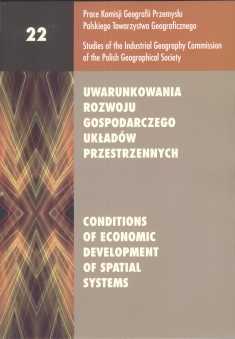Analysis of Spatial Development in and Around the City of Isparta through Remote Sensing and Geographic Information Systems
DOI:
https://doi.org/10.24917/20801653.22.9Keywords:
remote sensing, GIS, City of Isparta, Spatial Analysis, Land UseAbstract
Remote Sensing is a method of examination used in the study of resources on earth without any physical contact. It is a method by which the characteristics of the land below are recorded from space and sky. Determining the characteristics of natural and cultural resources of earth, sustainable exploitation of these resources in the most effective ways and continuous monitoring of the changes in these resources are fundamental to being a developed country. For a sustainable land use and urbanization, data about the unstable natural environment must be collected and monitored at regular intervals, and in order to do these, Remote Sensing (RS) and Geographical Information Systems (GIS) are employed. Images obtained through RS method can be analyzed for the accurate use of the data available. This study seeks to determine the spatial development in and around the city of Isparta through digital imaging processing techniques on different satellite images which belong to different years. Images from satellites ASTER and LANDSAT; information on the quarters in Isparta and the city plan and ERDAS IMAGINE 9.1 program were used in the study. The spatial development of the city of Isparta was studied on the basis of the satellite images obtained in the years 1987, 2000 and 2010 and this study was integrated into GIS. Having analyzed how much change occurred and which way it trended, important information was collected which will be used as source for future studies to be carried out on Isparta. It was observed that while residential areas increased, amount of forested land, and agricultural areas decreased during the periods studied.
Downloads
References
Akdemir, S. (2008). XVIII. Yüzyılın İlk Yarısında Isparta: Sosyo-ekonomik ve Kültürel Hayat, Isparta: Isparta Valiliği İl Kültür ve Turizm Müd. Yay.
Aksu, F. (1944). Isparta’nın Mahalle Adları Üzerine Bir Araştırma. Ün Dergisi, C.XI/123–124, 1715– 1718.
Arıkan, Z. (1988). XV–XVI. Yüzyıllarda Hamit Sancağı. İzmir.
Aster Satellite Image (2010). VNIR 15 Metre Spatial Resolution.
Avcı, S., Döker, F. (2005). Ömerli Havzası-İstanbul’da Mekânsal Değişimin Uzaktan Algılama Metodları İle Belirlenmesi. Ege Coğrafi Bilgi Sistemleri Sempozyumu Bildiriler Kitabı. İzmir.
Başbakanlık Osmanlı Arşivi. Konya Vilayet Salnameleri (1877, 1982, 1992). Ankara.
Başbakanlık Osmanlı Arşivi. Temettuat Defteri (1844). İstanbul.
Böcüzade, S.S. (1983). Kuruluşundan Bugüne Kadar Isparta Tarihi. Serenler Yayınevi. İstanbul.
Çetin, S. (2011). Dönüşüm Süreçlerinin Tarihi Kent Merkezleri üzerine Etkileri: Isparta Örneğinde Bir İnceleme, Erciyes Üniv. Fen Bil.Enst. Dergisi, V.27, I.2., 185–199.
Emecen, F. (1999). Isparta. DİA, C.XIX, s. 194–200. İstanbul.
Harita Genel Komutanlığı (1983). 1/25000 Ölçekli Topografya Haritası (M25a4). Ankara.
Isparta Belediyesi (2012). İmar Verileri, İmar Müd. Isparta.
Isparta Belediyesi (2012). Isparta Şehri İmar Planı. İmar Müd. Isparta.
Landsat Satellite Image (1987). TM 30 Metre Spatial Resolution.
Landsat Satellite Image (2000). ETM 30 Metre Spatial Resolution.
Temurçin, K., Babacan, H. (2006). IXX. Yüzyılın İlk Yarısında Isparta Şehrinin Sosyo-Ekonomik Yapısı ve Gayri-Müslimler. Atatürk Kültür Merk. Erdem Dergisi, S. 45–46–47, 155–182.
Temurçin, K. (1998). Isparta Şehri. İstanbul Üniv.Sos.Bil.Enst. Yüksek Lisans Tezi, İstanbul.
Temurçin, K. (2004). Isparta İli Ekonomik Coğrafyası. Ankara Üniv. Sos.Bil.Enst. Doktora Tezi, Ankara.
Türkiye İstatistik Kurumu (2012). TUİK Adrese Dayalı Nüfus Kayıt Sistemi Nüfus Verileri. Ankara.
Yıldırım, Ü., Kılıç, F. (2006). Uzaktan Algılama Yöntemleri ile Afyonkarahisar’ın Şehirsel Gelişiminin İzlenmesi. Fatih Üniv. 4. Coğrafi Bilgi Sistemleri Bilişim Günleri, İstanbul.
Downloads
Published
How to Cite
Issue
Section
License
Articles are published under the terms of the Creative Commons License (CC BY-ND 4.0; Attribution– NoDerivs).

